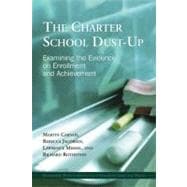
| Introduction and summary | 1 | (8) | |||
| Chapter 1. The reaction to the AFT's report on charter school scores | 9 | (8) | |||
| Chapter 2. Can the 'dust-up' lead to a new consensus in education research and policy? | 17 | (4) | |||
| Chapter 3. Problems with the critiques of the NAEP report by charter school supporters | 21 | (8) | |||
|
21 | (2) | |||
|
23 | (2) | |||
|
25 | (4) | |||
| Chapter 4. Are charter school students more disadvantaged than regular public school students, and does this explain charter schools' unexpectedly low NAEP scores? | 29 | (38) | |||
|
29 | (4) | |||
|
33 | (3) | |||
|
36 | (11) | |||
|
37 | (1) | |||
|
37 | (3) | |||
|
40 | (1) | |||
|
41 | (1) | |||
|
42 | (1) | |||
|
42 | (1) | |||
|
42 | (1) | |||
|
42 | (1) | |||
|
43 | (1) | |||
|
44 | (1) | |||
|
44 | (1) | |||
|
44 | (1) | |||
|
45 | (1) | |||
|
45 | (2) | |||
|
47 | (1) | |||
|
48 | (3) | |||
|
51 | (16) | |||
| Chapter 5. What we know about relative charter and regular public school student achievement | 67 | (42) | |||
|
67 | (3) | |||
|
70 | (28) | |||
|
70 | (1) | |||
|
71 | (21) | |||
|
80 | (1) | |||
|
81 | (4) | |||
|
85 | (1) | |||
|
86 | (1) | |||
|
86 | (1) | |||
|
86 | (1) | |||
|
87 | (1) | |||
|
87 | (1) | |||
|
88 | (1) | |||
|
89 | (1) | |||
|
89 | (1) | |||
|
89 | (3) | |||
|
92 | (3) | |||
|
95 | (2) | |||
|
97 | (1) | |||
|
98 | (8) | |||
|
106 | (3) | |||
| Chapter 6. The philosophy of charter schools | 109 | (16) | |||
|
109 | (7) | |||
|
116 | (9) | |||
| Chapter 7. Conclusion | 125 | (2) | |||
| Appendix A. Using different standards for evaluating charter and regular public schools | 127 | (14) | |||
|
127 | (3) | |||
|
130 | (2) | |||
|
132 | (1) | |||
|
133 | (1) | |||
|
134 | (3) | |||
|
137 | (1) | |||
|
138 | (3) | |||
| Appendix B. Alternative presentations of NAEP charter school demographic data | 141 | (4) | |||
| Endnotes | 145 | (18) | |||
| Bibliography | 163 | (14) | |||
| Acknowledgments | 177 | (2) | |||
| About EPI and Teachers College Press | 179 | (1) | |||
| Titles of special interest to educators from the Economic Policy Institute | 180 | (4) | |||
| Titles of special interest to educators from Teachers College Press | 184 |
The New copy of this book will include any supplemental materials advertised. Please check the title of the book to determine if it should include any access cards, study guides, lab manuals, CDs, etc.
The Used, Rental and eBook copies of this book are not guaranteed to include any supplemental materials. Typically, only the book itself is included. This is true even if the title states it includes any access cards, study guides, lab manuals, CDs, etc.